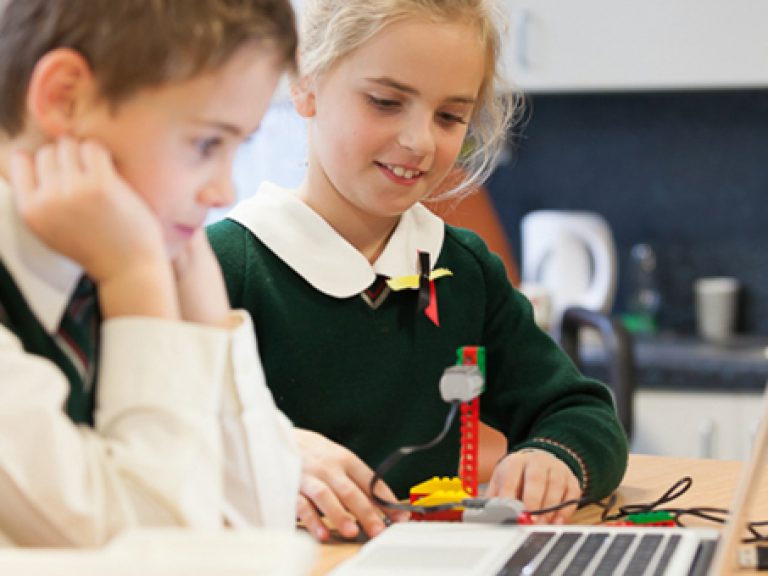By Angela Thomas
Coordinator of Gifted Education 6-12
Science, Technology, Engineering and Mathematics (STEM) are a central preoccupation of policy makers all around the world. This paper will outline the importance of STEM for future success of individuals and communities. The significance of providing educational opportunities in STEM will be detailed and in particular the creative and challenge possibilities that STEM education can provide for gifted students. Finally the focus area of computer coding that has been impacting globally on K-12 STEM education recently and its application in our own school context will be explored.
A vibrant capacity in Science, Technology, Engineering and Mathematics (STEM) is pivotal to increasing our nation’s productivity, and innovation in this area is key to creating jobs and enhancing competitiveness in our economy.2,6,8. STEM is the lifeblood of emerging knowledge-based industries (biotechnology, ICT and advanced manufacturing); it offers competitive advantage to established industries (agriculture, resources and healthcare) and is particularly critical in our education sector.8. The demand for STEM skills will continue to grow with international research indicating that 75 per cent of the fastest growing occupations now require STEM skills and knowledge. 8. Many nations including Australia are closely focused on advancing STEM and some have evolved dynamic and productive strategies. In Australia the STEM economic policy agenda is largely driven by the need to enlarge the high-skill group of professionals capable in research, commercialisable innovation and effective response to technological change.6. STEM qualifications prepare graduates for a range of occupations not only needed in traditional highly skilled STEM occupations but also the value and transferability of STEM competencies to a broad range of occupations is recognised. Governments need to lift the overall scientific literacy of their populations and to draw more students into senior secondary school studies in STEM.6. High performing countries are characterised by a STEM-literate population that celebrates discovery and entrepreneurship.8. The STEM disciplines are seen as essential for work and citizenship, enhancing global economic competition and social creativity.6.
An education in STEM fosters ways of thinking that enable individuals to see and grasp opportunities 8. and is potentially a new educational paradigm for giving our students the tools see the world and solve problems.11. Many countries with strong STEM agendas have a well developed curriculum focused on innovation, creativity and reasoning, accompanied by a strong commitment to STEM disciplinary knowledge.6. At the core of quality STEM learning are pedagogies of problem solving, inquiry, critical thinking and creativity, all of which can enhance both students’ attitudes to, and practical competencies, in STEM fields and promote lifelong learning.6. Successful practices in STEM-strong countries include the important role of industry partnerships in supporting innovation in school mathematics and science, the building of family and community understanding of STEM literacy and setting targets to improve STEM education participation and teaching.6. STEM as a philosophy is grounded on the solution of problems resulting from a multi-faceted and inter-disciplinary perspective, not just in the areas of science, technology, engineering or maths, but also integrating subject matter that may be relevant to problems such as environmental, social, regulatory, political and economic aspects.11. This is how engineers solve ‘messy’ problems large and small everyday, and for this reasons engineering needs to be an important part of any successful STEM program.11. STEM-rich educational opportunities need to be designed to support interdisciplinary investigations and creativity using a STEM-rich palette of tools, concepts, and phenomena.4.
STEM education is also a stimulating model for giving our gifted students the capacity to compete in our competitive global economy,11 it is important to ensure these students have a learning environment that lifts the ceiling and fosters potential to lead to creative and productive futures in STEM.2. Gifted students need daily challenge in their area of talent, this challenge needs to be rigorous and challenging enough to reduce the stress that is often associated with unchallenging classroom situations.10. Further, the preference of gifted students for whole-to-part concept teaching particularly in the areas of Mathematics and Science detailing how gifted learners acquire information about concepts as a whole rather than learning chunks, they are more likely to switch to alternate strategies when faced with a new challenge they cannot solve and show significantly higher learning gains when involved in problem-based science learning opportunities.10. This correlates with some of best global practices in STEM education focusing on multi-faceted open-ended problems supported with a commitment to critical thinking and creativity.6. Opportunities for learning high-level, innovative STEM should be readily available, including investigation of challenging, rich, complex problems, conducting authentic research, joining STEM clubs and accessing mentors in industry to support our gifted students.2.
Creative production in STEM requires visual-spatial ability and this ability must be further developed in education with more efforts to accommodate gifted spatial learners and develop spatial talents.3. Historically visual-spatial ability has been used to determine suitability for skilled work such as a technician or mechanic, however recent research supports the importance of visual-spatial ability in creative productivity in STEM domains.3. A student with superior visual-spatial ability is able to create mental representations of complex ideas and then mentally manipulate those representations, students who have this superior visual-spatial ability are more likely to become engineers or physical scientists.3. There are difficulties in identifying visual-spatial ability in many gifted education identification measures, as many students do not have uniformly high abilities across all cognitive domains. We need improved identification tools to recognise the gift of visual-spatial ability and then be more able to promote the provision of developmentally appropriate STEM-rich experiences for high visual-spatial learners in our schools.3.
Computer programming or coding is making a comeback in curriculum around the world in response to industry concerns about previous ICT courses that were too lower order and focused too heavily on computer literacy of how to use a computer rather than how the computer works. This is not new, “in the late 1960s, Seymour Papert began asking, ‘Does the computer program the child or the child program the Computer?’ …. personal fabrication, programming and physical computing shift the emphasis from passive consumption to active creation and invention”.7. New computing science curriculum that has been developed globally, including Australia is ambitious, stretching and drawn from consultation with industry experts. It allows schools more freedom, it is designed to equip every child with the computing skills they need to succeed in the future, including teaching them how to code, and how to create their own programs.1,5. The new Australian Digital Technologies curriculum provides students with practical opportunities to use design thinking and to be innovative creators and developers of digital solutions and knowledge.1. The aim is to provide students with authentic learning challenges that foster curiosity, confidence, persistence, innovation, creativity, respect and cooperation.1.
With this in mind we developed a ‘Code, Connect, Create’ day for our Year 7 students to proactively promote excellence in STEM for girls and engage with the broader STEM network working in collaboration with the University of Technology (UTS) Faculty of Engineering and Information Technology students. The day provided opportunity for our girls to participate in hands on workshops in engineering and IT and to hear from experts in industry talk about their careers. Students rotated through three workshops facilitated by university students; the aim was to encourage creative thinking, problem-solving skills and digital confidence.
These workshops included:
- Programming in Python where students learnt to code with Python, a powerful and fun programming language that can be use in web development, to write desktop applications and create games.
- Live lights, smooth sound, cool code workshop focused on developing simple code to design a light and sound display using the Powerhouse Museum’s Thinker1 boards. Students learnt about the basics of the Arduino programming language as well as some of the key concepts of circuit building used in electronics and robotics.
- Engineering workshop involved students investigating the design and use of a robotic arm, this was followed by a creative thinking exercise where students developed a project, based on Rube Goldberg Machines.
The students thrived in the complex and challenging environment that was fostered in the workshops and their feedback comments share the enthusiasm they had for the learning experiences:
“I really like having a conversation with the computer and I like typing up all the code. I learnt how to have a conversation with the computer and I learnt how to type and read code, now I know how to use commands and make a small game. Sometimes I typed up the wrong thing and that caused errors and it got a bit frustrating.”
“In this workshop I learnt how to power LED lights and sound from coding a computer using software. I personally thought that this was one of the hardest of the day but that’s what made it enjoyable”.
“In this workshop we learnt how to be creative learners with the resources that we had. I enjoyed this workshop because it let us be creative and have fun while doing it. The thing that was challenging was that you had to do a lot of trial and error because not all the time your ideas would work so you had to develop different ideas”.
Following on from our ‘Code, Connect, Create’ day we are ensuring broader opportunities for coding in our Technology courses, providing co-curricular opportunities in coding and robotics and encouraging participation in outside school competitions and coding communities.
Science, Technology, Engineering and Mathematics (STEM) are important to our future productivity and global participation in innovation and research. We as educators need to find ways to implement inspiring STEM-rich learning experiences that provide learners, including our gifted students the opportunity to think critically, create and innovate from multi-disciplinary viewpoint to step up to a STEM future.
References:
- ACARA. (2013). Draft Australian Curriculum: Technologies Retrieved from http://www.acara.edu.au.
- Adams, C., Chamberlin, S., Gavin, M. K., Schultz, C., Sheffield, L. J., & Subotnik, R. (2008). The STEM promise: Recognizing and developing talent and expanding opportunities for promising students of science, technology, engineering and mathematics. National Association for Gifted Children. Washington, DC: .
- Andersen, L. (2014). Visual–Spatial Ability: Important in STEM, Ignored in Gifted Education. Roeper Review, 36(2), 114-121. doi: 10.1080/02783193.2014.884198
- Bevan, B., Gutwill, J. P., Petrich, M., & Wilkinson, K. (2015). Learning Through STEM-Rich Tinkering: Findings From a Jointly Negotiated Research Project Taken Up in Practice. Science Education, 99(1), 98-120. doi: 10.1002/sce.21151
- Gove, M. (2014). Michael Gove speaks about computing and education technology. https://http://www.gov.uk/government/speeches/michael-gove-speaks-about-computing-and-education-technology
- Marginson, S., Tytler, R, Freeman, B and Roberts, K. (2013). STEM: Country comparisons. Report for the Australian Council of Learned Academies, Retrieved from http://www.acola.org.au.
- Martinez, S. L., & Stager, G. S. (2013). Invent To Learn: Making, Tinkering, and Engineering in the Classroom: Constructing Modern Knowledge Press.
- Office of the Chief Scientist. (2014). Science, Technology, Engineerig and Mathematics: Australia’s Future. Canberra: Retrieved from http://www.chiefscientist.gov.au.
- Papert, S. (2002). Hard Fun. Bangor State News. Retrieved from http://www.papert.org/articles/HardFun.html
- Rogers, K. B. (2007). Lessons Learned About Educating the Gifted and Talented: A Synthesis of the Research on Educational Practice. Gifted Child Quarterly, 51(4), 382-396.
- Roman, H. T. (2012). STEM-Its Importance and Promise for Gifted Students. http://site.njtea.org/wp-content/uploads/2012/01/STEM-Article-for-IAGC-Journal.pdf





